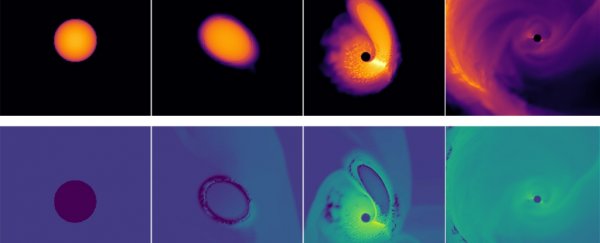Black holes are famous for tearing apart and devouring stars. But new simulations suggest that, in the very final moments, black holes can actually bring stars back to life.
But only certain stars, in certain conditions - and the perfect storm involved could help solve a perplexing black hole mystery.
So, how is this possible? If a white dwarf - or indeed any star - ventures too close to a black hole, it's kaput. But what happens next is one of the most violent processes in the Universe.
The incredibly immense gravitational pull of the black hole - what we call its tidal force, the same force that the Moon exerts to cause the ocean tides (only on a much larger scale) - will tear the star apart, and devour, or accrete, the remains.
But if the star is a white dwarf, the evolutionary endpoint of low- to middle-mass stars like our Sun, something interesting can happen.
In these white dwarves, hydrogen fusion has already come to a halt before they get gobbled up.
But as the black hole's tidal forces simultaneously stretch and compress the star in opposing directions in what is called a tidal disruption event, the compression can actually reignite fusion in the star's core, even if just for a few seconds, according to new simulations. The destroyer of worlds instead feeds the spark of life.
There's a big catch, though: this can only happen if it's an intermediate mass black hole. And for some reason, those seem to be missing from the Universe.
There are two categories of black holes in the Universe. There are your regular, run-of-the-mill stellar-mass black holes, typically below around 100 times the mass of the Sun. These are the ones whose collisions are responsible for gravitational wave observations.
Then there are the supermassive black holes, ranging from a lower limit of around 100,000 solar masses, but ranging up to millions or billions of solar masses. Sagittarius A*, the supermassive black hole at the centre of the Milky Way, is about 4 million solar masses.
The category that should, hypothetically, be in the middle - from 1,000 to 100,000 solar masses - has proven very elusive. The best candidate yet turned up earlier this year, but it's still not a 100 percent conclusive result.
But neither stellar-mass nor supermassive black holes will produce the white dwarf resurrection effect, the researchers said.
It's a Goldilocks problem - a stellar-mass black hole is quite physically small, which means that initially the white dwarf will engulf it; and a supermassive black hole's tidal forces are so strong that the star will fall into it before it can be disrupted.
So knowing that an intermediate black hole's influence on a white dwarf could cause it to reignite could help identify the mysterious black hole "missing link".
"It is important to know how many intermediate mass black holes exist, as this will help answer the question of where supermassive black holes come from," said astrophysicist Chris Fragile of the College of Charleston.
"Finding intermediate mass black holes through tidal disruption events would be a tremendous advancement."
It won't be easy - although they can produce an incredible amount of electromagnetic energy as the black hole spews out relativistic jets, only a handful of tidal disruption events have ever been detected, and none of these seemed to bear the signature of a white dwarf.
If a white dwarf was to be swallowed by an intermediate mass black hole, the reignited nuclear fusion can convert the typical white dwarf composition of helium, carbon, and oxygen into heavier elements such as iron and calcium.
The team's simulations show that, when the white dwarf is a little farther away from the black hole, more calcium is produced; but when it's closer, more iron is produced.
Since not all of the star ends up devoured by the black hole, these elements can then be blown out into space, where eventually they'll be incorporated into new stars.
The team's simulation also showed that these events can produce short bursts of faint gravitational waves. We don't currently have equipment sensitive enough to detect them, but that doesn't mean we won't in the future.
Meanwhile, a number of telescopes are already looking for tidal disruption events. The team's simulations could help find and characterise them - and hopefully shed some light on these strange and elusive black holes.
The research is due to be published in The Astrophysical Journal, and can be found on preprint resource arXiv.
